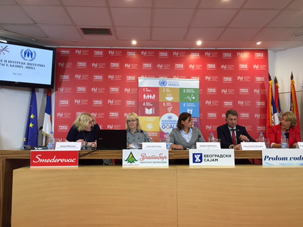The publication of the Commissariat for Refugees and Migration on the situation and needs of internally displaced persons from Kosovo and Metohija (KiM), developed with support from the Representation of the UN Refugee Agency (UNHCR) in Serbia, was presented in Belgrade today.
In cooperation with the Republic Statistical Office, UNHCR and others, the Commissariat for Refugees and Migration, has conducted regular surveys on internally displaced persons (IDPs) and their needs since 2008. The latest publication "Situation and Needs of Internally Displaced Persons" as of May 2018, was prepared by the Commissariat based on data collected by trustees for refugees in their municipalities. A database was established by the Commissariat in 2013, and is regularly updated. It includes key data on IDP households and their members, social vulnerability as well as the expressed need for improvement of living conditions.
There are currently 199,584 internally displaced persons from Kosovo and Metohija in Serbia.
The survey shows that 68,514 IDP (16,644 families) in need live in Serbia (excluding KiM). Most reside in urban areas in Western Serbia and Šumadija, and a number of them in Vojvodina.
Most IDP are between 19 and 59 years old, while their median age is 39. The share of women and men is approximately the same (49.21% and 50.79% respectively). The average size of IDP households in need is 4.12.
The total IDP population includes 21,000 Roma (10.5%). Most IDPs in need declared themselves as ethnic Serb (76.7%), followed by Roma (14.9%), and significantly lower percentage of Montenegrins, Bosniaks, Muslims and Gorani. 1,435 internally displaced Roma families (10,188 persons) in need live in Serbia. Many Roma IDP live in more precarious conditions than other citizens of Serbia, other IDPs, and even than non-IDP Roma.
Less than 10% of IDPs own housing, while more than 50% rent apartments or live with family and friends. As many as 5,500 IDP families live in inadequate housing which could be substantially improved.
Almost 50% of these IDP favour the provision of construction material as an option for resolving their housing problem, while 20% would favour to be provided with village houses. Rented housing is perceived as the best solution by 19.5% of IDP families, and social housing in supportive environment by 10.5% families.
More than 50% of IDPs in need (56.5 %) state that their property in KiM was destroyed, and 11.25 % that the damage to their property is at a scale which renders it uninhabitable. According to the survey, only 7% of IDPs consider returning to their places of origin. The duration of displacement contributes to loss of hope and wish to return. According to the IDPs, the key preconditions for return are security (58%) and reconstruction and restitution of property (20%).
"The UN Refugee Agency is very grateful to the Commissariat for having produced this excellent study. It shows the dire needs which too many IDPs still face close to 20 years after they fled KiM, as well as the strong efforts of the Commissariat over those years to improve IDP’s situation, leading to an appeal for increased national and international resources. We strongly support that the national development plan of Serbia addresses IDP needs and ensures that IDPs will not be left behind in Serbia’s progress in European Integration and the Agenda 2030 for sustainable development," concluded the Representative of UNHCR, Hans Schodder.
The Deputy Commissioner for Refugees and Migration of the Republic of Serbia, Svetlana Velimirović said "The job of the Commissariat is indeed to regularly monitor the needs of beneficiaries in order to maximize the available, limited funds" and advised that "Best practices of the Regional Housing Programme to resolve the issues of the most vulnerable refugees from former Yugoslavia could be used also as a model to resolve the housing needs of IDPs from Kosovo and Metohija."














